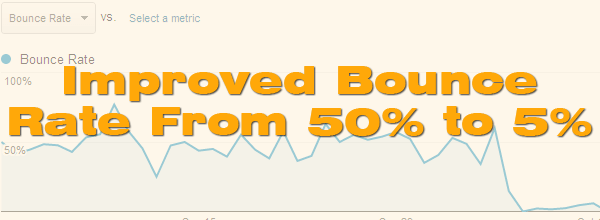To protect the privacy of our clients, only general information will be provided in this SEO case study. The name of the company and keywords targeted will not be provided unless our client has permitted us to utilize this information.
Bounce rate. It’s one of those metrics that most of us have heard of but few of us pay much attention to. However in my opinion, bounce rate is one of the most important metrics when it comes to online marketing. Who cares if you have 1,000,000 visitors coming to your site if you have a 95% bounce rate? And likewise having 100,000 visitors is fantastic if you have a 10% bounce rate. This case study will look at two projects we worked on in which we dramatically improved the bounce rate, which subsequently improved all other aspects of the website, business, and marketing campaign.
What Is A Bounce Rate?
A bounce is simply when someone comes to your website, views one page on the site, and leaves. So a bounce rate is simply the percentage of people who visit your website and leave without viewing any additional pages ( number of people who “bounce” divided by total number of visitors). Most people who visit a website and “bounce” never end up coming back. So the ultimate goal of any marketing company is to get people to stay on a website longer and prevent bounces. When you prevent bounces and get visitors engaged in the website and the content, the chance of having them convert (call, sign up, buy something, etc.) is dramatically higher.
We’ve seen bounce rates range from 85% on the extremely high end to 2% on the extremely low end. I would estimate that most websites should have a bounce rate between 25% and 35%, that is 1 in every 3-4 visitors ends up bouncing, while 2 in every 3-4 visitors ends up staying on the site for more than 1 page.
How Do You Improve Bounce Rate?
Improving bounce rates isn’t always an easy question to answer. Quite honestly it takes years of experience to know what does/doesn’t work, and even then it can require some experimenting to find out what changes are needed to the website to lower the bounce rate. In general, here a few of the most common problems on a website that cause a high bounce rate:
- Outdated web design: People don’t like going to websites that look like they haven’t been updated in years. This is probably the most common reason why people leave a website.
- Website errors: If you have errors on your website, things that overlap, or other technical problems, people will almost always bounce off the website. Many websites have problems in certain browsers that can cause a high bounce rate or problems on tables/mobile devices.
- Bad layout: Websites that are cluttered, have too many ads, or are difficult to visually look at are likely candidates for a high bounce rate.
- Bad navigation: Websites that don’t have an intuitive navigational structure or websites where visitors can’t find what they’re looking for are likely to have a higher bounce rate.
- Bad traffic: Sometimes the website is fine, but the sources of traffic are poor. For example, a doctor’s website will have a high bounce rate if all his traffic is coming from ads on a car dealership’s website or a website will have a high bounce rate if it ranks for poor quality/improper organic search terms.
Below we’ll take a look at two case studies with data from Google Analytics outlining changes in bounce rates and talking about what we did to improve the bounce rate so dramatically.
Study 1: From 50% to 5% Bounce Rate:
Below is a graph directly from Google Analytics showcasing a dramatic reduction in bounce rate, from about 50% to about 5% after we launched this client’s newly designed website:

In this example, the client was earning revenue through subscriptions via the website as well as through advertisements on the actual website. It was extremely important for this client to have a higher number of page views on the website and a lower bounce rate to be able to attract more advertising contracts on the site.
The site was extremely dated, which likely contributed to part of the bounce rate issue, however beyond that we made several specific changes to the site to help lower the bounce rate:
- Navigation: We improved the navigational structure of the site to the core pages by redesigning the navigational menu, adding drop downs, and incorporating sidebars into all core pages to have a horizontal navigation bar to assist with page specific navigation.
- Graphics: We updated the graphics and images throughout the site to be more visually stimulating and have stronger calls to action. This greatly improved the flow of traffic throughout the site.
- Focus: We removed elements of the website that weren’t needed, were redundant, or were otherwise blurring where we wanted the flow of traffic going on the website.
- Technical Specs: We built out this site to be responsive, that is scale properly on devices from mobile phones to smart phones to tablets to laptops to desktops. This assisted them greatly as this site had visitors from 200 countries around the world, all with different types of technology.
In addition to these changes, our team used their experience to make other subtle changes that would result in a better bounce rate and more page views. In addition to improving the bounce rate, we also dramatically increased the number of page views as shown below:
After launching the new site, we were able to bring this site from about 5,000 page views per day up to about 8,000 page views per day. For many sites this isn’t an extremely important metric, however in this case for a site being paid for advertising impressions it is extremely important as it will assist in generating new ad revenue.
Study 2: From 58% to 28% Bounce Rate:
Below is a graph directly from our client’s Google Analytics account showing a decrease in bounce rate, from 58% to 28% after a complete website redesign:

While this example is not as dramatic as the first scenario, a 30% reduction in bounce rate definitely makes a big difference. In this case, the client’s website was actually just designed a year ago by another web design firm, however the firm focused on web design and wasn’t marketing based. One of the things we do with every website is make sure it’s your company’s best sales person, not just a paper weight. Your website exists for two purposes: to provide information to prospects and customers and to act as a lead/sale generating tool for your business. In this case, the old website had the following problems that we resolved and thus improved the bounce rate:
- Call To Action/Navigation: Website visitors need to be told where to go and what to do. When you wait in line at an amusement park, it isn’t just a free for all, there are lines and ropes to tell you exactly where to go along with a map. In this case, we updated the navigational structure and added clearer calls to action.
- Core Content: The site’s content was disorganized and difficult to read. Our copy editors were able to improve the content, and our development team was able to better organize the site’s content by breaking it down into 6 core categories with sidebar navigation menus to assist in flow.
- Blog/News: Previously the site had numerous sections for blog and news items, however was only posting a few times per month. We cleaned that up with one central blog/news area and designed a custom template for them depending on what they of story there were posting.
- Sliders: We utilized a JQuery slider on the homepage with clear calls to action to help direct traffic to the 5 core areas of the website we wanted it going.
The newly launched site not only looks much better than the old one, but it functions much better which is equally as important.
The Bottom Line:
Bounce rate is often overlooked, however it truly is an important metric no matter what industry your website is in. How your visitors view your website and navigate around it is extremely important as you want them going to the places they should be going, and not getting lost in a mess of pages. Check what your website’s bounce rate is, and if it’s over 40 or 50% then you should definitely consider making changes to improve it and ensure your website visitors aren’t leaving a few seconds after landing on your site.

 Menu
Menu 






